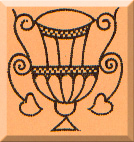
 |
ASPROM | |||||||||||||||||||
The Association for the Study and Preservation of Roman Mosaics |
||||||||||||||||||||
| About ASPROM | News & Events | Publications | Mosaics in Britain | Resources | Join ASPROM | |||||||||||||||
This paper proposes a new identification for a damaged panel in the great mosaic of room XII at Brading, and identifies the version of the subject, surviving as a mural at Pompeii, from which the figures are drawn. It also discusses other Romano-British examples of the theme and their iconographical origins.
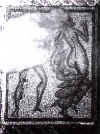 |
| Fig. 1: The Achilles panel at Brading. |
Of the four rectangular panels that circle the Medusa head in the outer reception area of room XII at Brading villa, only one has defied interpretation because of its shattered condition. The others have been identified as Lycurgus and Ambrosia, Ceres and Triptolemus, and Attis and Sagaritis. The panel in question shows a running woman and a stationary man (fig. 1).
Various ideas have been mooted as to the subject portrayed from nymph and satyr, Neptune and Amymone, to Apollo and Daphne, but none have been satisfactory. It seems inconceivable that with three recognisable couples on the floor an anonymous nymph and satyr would be chosen, especially as the subject would need to be as instantly recognisable to the viewer as are the others. The woman has no attributes to aid her identification, so these, whatever they might have been, were carried by the man. The only obvious movement in the scene comes from the woman. She looks towards the man, twisting her body as she starts to run. Her right hand is raised with the fingers spread wide in a gesture of shock and surprise, indicating that this emotion has just come upon her. The urgency is shown by the violent folds of the garment as it both falls from her shoulders and streams out behind as she turns to run. The male makes no attempt to pursue her, and there is no indication that he has been doing so, as would be expected if it were Apollo and Daphne. Moreover, she shows no signs of sprouting laurel leaves on the one hand shown (the other is hidden in a roll of garment). What then has frightened her about the figure? He stands in a confrontational pose with legs apart, his body lost beyond the thighs. The author believes that the most likely solution is that one is here dealing with another depiction of the widely popular subject of the discovery of Achilles on Scyros, with the hero, who has been disguised as a woman, undraped and unmasked as he strips for battle and grabs the weapons provided by Diomedes and Ulysses on the sounding of war trumpets, thus causing consternation amongst the daughters of Lycomedes. The action is condensed, as is the Romano-British way, into two main visual elements of the original crowded composition, namely the hero and one girl.[1]
There were several famous depictions of this subject in antiquity, all of which relate to one another in some element of their composition. One version from Pompeii which survives in at least three examples from that city has the hero restrained whilst reaching for his shield. Another, of which versions survive from El Jem and Keynsham, has a seated Achilles beginning to rise whilst grabbing his weapons. At Keynsham (fig. 2) the mosaic features the hero, a bearded man (presumably Lycomedes or the two other disguised rulers) and a shocked girl.[2]
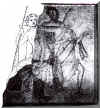 |
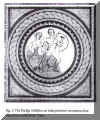 |
| Fig. 2: The Keynsham Achilles: an interpretative reconstruction based on a mosaic version of the scene from El Jem, now in Sousse Museum. | Fig. 3: The Rudge Achilles: an interpretative reconstruction based on a relief from Trier. |
The Achilles panel suggested by Cosh at Frampton would have to have featured a seated Achilles of this type as there is no room in the lacuna for a standing figure in any of the traditional poses. The author is inclined to believe this Frampton panel is a version of the painting from the House of Jason, Pompeii, showing Medea in a garden contemplating the murder of her children, watched over a wall by a bearded figure identified as either their father (Theseus) or their tutor. Both the bearded man and the bench in the bottom right hand corner on which Medea sits in the original picture here survived. However the Achilles identification is still a possibility.[3]
The most common and memorable image of Achilles from antiquity shows a diagonally posed figure with an upraised shield in his left hand and a weapon in his right. Reproduced so frequently in all forms of the decorative arts, this dramatic pose must have been instantly recognisable, as the figure at Brading would have been if provided with weapons. Found generally to one side of early painted compositions, it had by mid-Antonine times been adapted to form the central focus of a multitude of versions, and appears on sarcophagi, murals, glassware and mosaics.[4] In Britain, versions of this shield-bearing figure existed at Rudge and at Horkstow in medallion 3c of the great Achilles pavement. Both of these featured Deidameia in different poses. The love interest of medallion 3c at Horkstow, which is emphasized by the presence of Venus, an amorino and an amorous triton and nereid in its border 3b, is likewise stressed on sarcophagi at Woburn and in the Louvre by the presence of three amorini surrounding the pair. Fowler’s drawing of the roundel clearly shows a shield rim between Achilles and Deidameia. The Rudge Achilles, first identified tentatively by Witts, can indeed be seen to be a fine example of the genre when subjected to an interpretative restoration. It echoes remarkably closely a clay relief from Trier (which has been used as the basis for the new reconstruction) and shows a seated Deidameia attempting to restrain her lover.[5]
Apart from the figure of Achilles, two other images are often stressed in these Scyros representations and are retained in the viewer’s memory. One is a litter of overturned tableware and work-baskets on the floor (symbolising the sudden end of female domesticity), but the most notable is surely the shocked or agitated female, turning to run, with hands upraised, and figures spread in fright at the sudden warlike occurrence. In abbreviating these crowded compositions the Romano-British mosaicist has at Brading and Keynsham retained only one of Deidameia’s shocked sisters, although it is possible that in both cases the visual reference is intended to represent the heroine herself. Similarly placed female figures occur by Achilles on sarcophagi and on a lunette painting at the Hypogeum of the Three Brothers at Palmyra. The closest parallel, and the best evidence that the Brading panel is an Achilles, comes from Pompeii.[6] In the House of the Vettii are the remains of a badly damaged variant of the Scyros scene that appears to record the lost original on which the Brading figures are based.
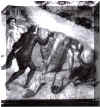 |
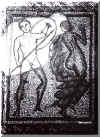 |
| Fig. 4: The Achilles painting from the House of the Vettii, Pompeii. The two figures on the right-hand side of the picture compare with those from Brading. | Fig. 5: Achilles on Scyros: an interpretative reconstruction based on the figures on the Vettii mural and the silver platter from Kaiseraugst. |
The female is almost identical on this mural to the mosaic one at Brading. Her stance, fall of garment, and the wrapping of the cloth about her left arm, are all faithfully transferred to the mosaic. Achilles appears to her immediate left as on the mosaic, and again his stance relates to that of the Brading figure. The only difference is the inclusion of a fall of drapery across his thigh. Of the males at Brading, only Attis, who is identified by his attire, is clothed, so this cloth was omitted as an irrelevancy by the mosaicist. The nude or semi-nude Achilles appears often in representations and at Rudge and Horkstow in Britain. Tragically the Vettii figure is also badly damaged, but enough remains to show that the hero held a spear at hip height. On the painting his wrist is grasped by Ulysses, but this was not included in the two-figure scene. Given the diagonal stance of the Vettii Achilles, the most likely restoration would be that he held a shield aloft on his left arm to be instantly recognisable. With the remarkable parallels between the Brading and Vetti figures, the mosaic’s hero is most probably also to be imagined with spear and shield so as to be again as close as the traditional image as possible. The Vettii Achilles probably looked towards Ulysses, not only as a natural reaction to having his wrist grasped, but also as the swing of his body to the right and the composition of the painting demands it. Although most of the Brading figures are portrayed nearly full face, much use is made of sideways glances, and as the fleeing girl is never the subject of Achilles’ attention, a glance ‘off canvas’ away from her seems most likely.
A curving line of plain tesserae in the top left hand corner of the Brading panel indicates where Achilles’ head was placed, and proves that the pose of the hero differed slightly from that of the Vettii painting. This was presumably necessary to accommodate the identifying and well-known image in the space available in the panel. It can be seen in the interpretative restoration how well the diagonal upper torso and weapons fit into the lacuna. Achilles’ stance copies that of the hero in the Scyros scene of the great silver platter from Kaiseraugst, which has provided the model for restoration.
The identification of this panel as Achilles on Scyros adds yet another copy of an ‘Old Master’ to the catalogue of what can only be described as a mosaic picture gallery at Brading.[7] The similarities between the panel and the two figures in the House of the Vettii mural are striking and further evidence of the longevity of images in popular art. It also provides further proof of the popularity of the Scyros subject amongst Romano-British patrons of the fourth century.
Notes | |
| 1 | Ling (1991) 15; Stupperich (1980) 297. |
| 2 | Kossatz-Deissman (1981) 63; Borriello (1989) figs. 205–6; Reinach (1922) 166–7; Beeson (1995) 5. |
| 3 | Cosh (1996); Borriello (1989) 135, pl. 75. |
| 4 | Kossatz-Deissmann (1981) many; Reinach (1922) 16–7; Neu (1994) cover; Schefold (1989) 113, 118. |
| 5 | Rudge: Witts (1995); Kossatz-Deissmann (1981) 72, pl. 169; Horkstow: Beeson (1993) 14, pl. 3; Angelicoussis (1992) 88–9; I am now convinced that Deidameia is the companion to Achilles in this medallion; Baratte (1985) 252–5. |
| 6 | Budde (1964) 102–3, pl. 56; Browning (1979) 41, pl. 14; Pompeii: Reinach (1922) 166, pl. XXIII, 7. |
| 7 | Beeson (1990) 18. |
Angelicoussis, E., 1992, The Woburn Abbey Collection of Classical Antiquities, Mainz.
Baratte, Francois, 1985, Musée du Louvre. Catalogues des sarcophages en pierre d’époques romaine et paleochretienne, Paris.
Beeson, A., 1990, 'Perseus and Andromeda as lovers. A mosaic panel from Brading and its origins', Mosaic 17,13–19.
Beeson, A., 1993, 'The Medallions mosaic; a new interpretation of the painted ceiling panel from the Orpheus Hall at Horkstow', Mosaic 20, 7–17
Beeson, A., 1995, 'Keynsham and its mosaics', Roman Research News 10, 4–6.
Borriello, M., 1989, Le Collezioni del Museo Nazionale de Napoli 1, Milan.
Browning, I., 1979, Palmyra, London.
Budde, L., 1964, Catalogue of the Greek and Roman Sculpture in the Fitzwilliam Museum, Cambridge, Cambridge.
Cosh, S. R. 1996, 'A possible Achilles at Frampton', Mosaic 23, 13–15.
Kossatz-Deissmann, A., 1981, 'Achilleus' in Lexicon Iconographicum Mythologiae Classicae 1, Zurich.
Ling, R., 1991, 'The iconography of the Brading Mosaics', Mosaic 18, 14–20.
Neu, S., 1994, 'Der farbige Achilles-Pockal', Antike Welt 25, 11, cover, 54–61.
Reinach, S., 1922, Repertoire des peintures grecques et romaines, Paris.
Schefold, K., 1989, Die Sagen von den Argonauten von Theben und Troia in der klassischen und hellenistichen kunst, Munchen.
Stupperich, R., 1980, 'A reconsideration of some fourth century British mosaics', Britannia 11, 289–201.
Witts, P., 1995, Images on Romano-British Mosaics, Unpublished thesis.
| © Anthony Beeson 1997. This article was originally published in Mosaic 24 (1997) 13–16. |